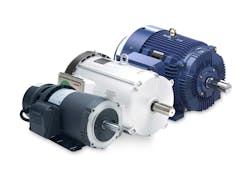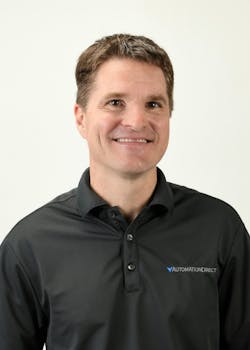Technologies such as robots and artificial intelligence may be getting all the attention these days, but motors remain just as essential to automated production as they have been for the better part of two centuries. That’s why it’s important for manufacturers to not take these automation workhorses for granted and think about how this mature technology can help their processes be more profitable and sustainable.
For some best practice insights on this fundamental automation technology, we spoke with Kevin McClelion, product manager at AutomationDirect.com.
AW: What are the main factors to consider when selecting an industrial motor for a specific application, and why are these factors important?
McClelion: The two most important factors are the power required to run your fan, pump or other field device and the voltage available at your facility.
Of these two factors, power is the most important to ensure proper operation of the mechanical equipment. If, for example, a conveyor requires 2 hp, and you only spec a 1.5-hp motor, the conveyor will not run. It might start up initially, but once you start loading it up, it will bog down and trip off. So, you have to get the required power right.
The voltage requirement is determined by what the building facility has available. In the U.S., the most common voltages are single-phase 120V and 230V and three-phase 230V and 460V. It’s best to choose a motor that matches the facility’s electric power.
If necessary, you can work around this voltage constraint, but it’s going to cost you more money and space. An intermediate device such as a transformer or VFD (variable frequency drive) must be installed to handle the voltage conversion.
Once power and voltage are defined, then you get into secondary selection criteria. Among these, speed is an important factor. About 75% of AC motors are 1800 rpm, four-pole units. The next most popular is a 3600 rpm, two-pole motor, which is typically used for fans requiring higher speeds. Then, there is a 1200 rpm motor, which is used in lower-speed, higher-torque applications.
Another important secondary factor is the enclosure and mounting, especially if it’s a hazardous-duty environment. The designs you pick can affect the longevity of the motor.
AW: What are the essential maintenance and troubleshooting practices for industrial motors?
McClelion: An electrical motor is a very robust piece of equipment that doesn’t require a lot of maintenance. Modern windings are built to withstand heavy-duty applications and voltage spikes from VFDs.
The weak points of a motor are the bearings that hold the shaft; that’s what takes all the abuse. So, care needs to be taken to mount the motor within its vibration specification. That will really help the longevity of the motor. Then, there are several key maintenance practices to perform:
- Visually inspect the motor on a regular basis.
- Clean any dust buildup on the fan, shaft or outside of the motor.
- Check the lubrication levels and ensure there are no signs of leaks.
- Turn the shaft and feel for smooth operation of the motor bearings.
- Check for smooth operation of the mechanical system attached to the motor. Bad bearings or friction in the mechanical system can reduce the life of the motor.
- Run the motor and check for any excessive vibration or noise.
AW: How do industrial motors contribute to overall energy management and sustainability goals for businesses?
McClelion: Electrical motors typically make up a very high percentage of overall electricity consumption in a manufacturing facility. Therefore, efficient motors can contribute significantly to energy management and sustainability goals.
The efficiency of electrical motors is noted by its NEMA (National Electrical Manufacturers Association) rating: standard, high, premium or super-premium efficiency. Regulatory agencies set efficiency percentages required for each motor horsepower at full-speed operation.
Upgrading from a standard-efficiency motor to a premium-efficiency motor may improve efficiency 2% to 3%. That can mean a three to four-year payback, depending on motor utilization and electricity rates. In other cases, such as if you’re running the motor only a couple of hours a day, it often doesn’t make sense to replace the motor strictly for financial reasons.
People tend to focus on the initial cost of the motor, but that’s only a small percentage of its overall lifecycle cost. For example, let’s say a 5 hp motor costs $600 to purchase. The electricity to run that motor during business hours—from 8 a.m. to 5 p.m.—260 days a year could cost roughly $500 to $600 dollars a year, depending on electricity rates. Considering that motors typically operate for many years, that’s why the purchase price of the motor is only a small percentage of the overall operating costs. From this perspective, spending a little more money on a premium-efficiency motor to lower operating costs makes good financial sense over the long term. So, when you’re purchasing new equipment, always ask if premium-efficiency motors can be used.
You can also lower a motor’s operating cost by installing a VFD to control the motor and run it at slower speeds. Slowing a motor by 20% can provide up to 40% in energy savings.
AW: What certifications or standards should industrial motors meet to ensure compliance with safety and performance requirements?
McClelion: There are two main standards for AC motors. In the U.S., low-voltage motor designs generally follow the NEMA MG1 standard. Outside of the U.S., most countries are using the IEC (International Electrotechnical Commission) standard.
Because of these standards, the motor industry is commoditized in a lot of respects. A 1-hp motor built to NEMA standards is going to have the same mounting conventions, shaft size and so forth, whether it’s from Marathon, WEG or other producer. So, you’ll be able to replace any NEMA motor, regardless of the manufacturer.
Both motor designs are robust, but there is some advantage to sticking with NEMA sizing in the U.S. because of its greater availability here. In the U.S., you will have more selection of manufacturers and price with NEMA than you will with IEC.
Many motors have UL or CSA marks from the Underwriter Laboratories or the Canadian Standards Association to certify that the motors have been tested and shown to meet certain requirements. On the other hand, electrical certification, or CE, marks indicate that the manufacturer, rather than a third party, certifies that a product complies with European standards.
Another kind of certification in the motor industry is the EASA accreditation, which is for service centers that repair and rebuild electrical motors. When larger, expensive motors fail, it can be economical to send them to an EASA-accredited shop for rebuilding. The breakeven point depends on a lot of factors, but typically only motors greater than 50 hp are repaired. Smaller motors are usually considered to be disposable items.
AW: What emerging technologies or trends in the industrial motor industry should automation professionals be aware of?
McClelion: The technology itself doesn’t change very much. Manufacturers will often sell a particular motor design for 20 years. Typically, what drives change in motor design is new efficiency standards issued by governmental agencies. That can force all motor manufacturers to update their designs.
About the Author
James R. Koelsch, contributing writer
Contributing Editor

Leaders relevant to this article:

